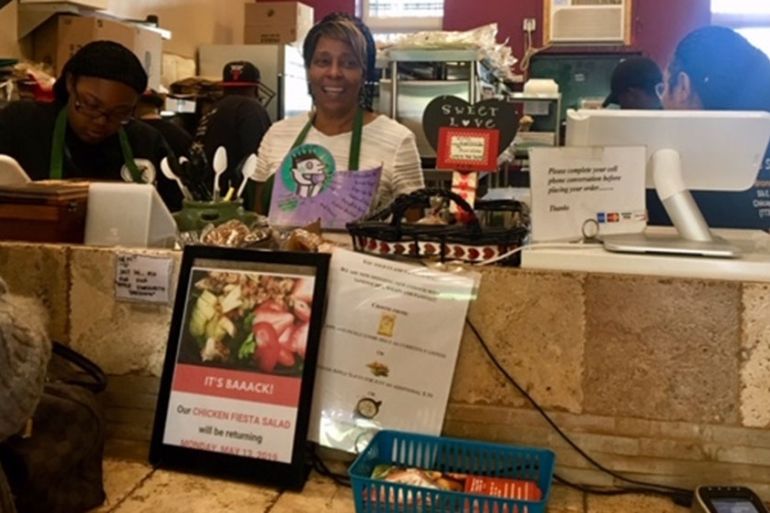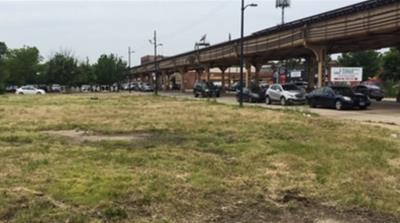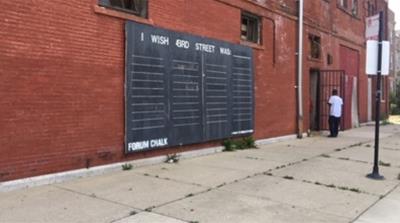Racial disparity: White neighbourhoods and investment capital
Urban Institute: Investors are putting significantly more money in Chicago’s white neighbourhoods

Chicago, United States – Margot Strotter has owned Ain’t She Sweet Cafe in Bronzeville for 12 years. It’s a popular restaurant in a neighbourhood where the majority of people, like her, are African-American. There are public programs in place for small businesses to obtain funding from the Chicago city government. But Strotter and her neighbours haven’t had much luck with that.
“I have found just in trying to get resources for renovations or upgrades,” Strotter said, “that it’s hard to get financing.”
Keep reading
list of 4 itemsBoeing hit with 32 whistleblower claims, as dead worker’s case reviewed
US imposes new sanctions on Iran after attack on Israel
A flash flood and a quiet sale highlight India’s Sikkim’s hydro problems
Strotter’s experience highlights the investment disparity between Chicago’s black and white neighbourhoods.
Struggling for funding
Chicago’s white neighbourhoods get more than 460 percent more private investment than black neighbourhoods, and 260 percent more investment than majority Latino neighbourhoods. These and other findings from a recent Urban Institute study point to a racial disparity in neighbourhood investment.

“The link between race and access to capital is clear, it’s severe and it’s concerning,” said Brady Meixell, co-author of the Urban Institute report. “It’s a large-scale American problem.”
The study evaluated investment flows in Chicago between 2011 and 2017 and found that at $67bn, private capital eclipsed the $4bn in government and philanthropic money disbursed during this period.
“When you compare public and mission-driven investment to private investment, it’s such a small piece of the pie it can’t make a huge difference,” Meixell said.
If you have no money, you get no money
In communities of colour, mission-driven investments play a significant role in getting businesses off the ground. However, as the Urban Institute study asserts, not only do these programs represent such a small segment of total funding that they cannot keep up with the private capital flowing to white neighbourhoods, but they are also often difficult to navigate.
Some public programs that provide grants to businesses in disinvested neighbourhoods are reimbursement-based. Put differently, if you have no money, you get no money. The City of Chicago’s Small Business Improvement grant, for example, provides up to $100,000 to repair or rehabilitate a single-tenant commercial property. These funds are disbursed as a reimbursement only after owners pay up front and complete the repairs. And even then, owners are only reimbursed for up to 75 percent of their costs.
The global racial gap
The investment disparity is not limited to Chicago – or the United States. In 2017, the United Kingdom conducted a Race Disparity Audit, which found significant differences in income levels, unemployment rates and homeownership levels across the country. The report found black households were the most likely of any group to have a weekly household income of less than 400 pounds ($503) per week, while “within every region, socio-economic group, income band and age group, white British people were more likely to own their own homes than all other ethnic groups combined”.
The link between race and access to capital is clear, it's severe and it's concerning. It's a large-scale American problem.
It’s a similar situation in South Africa, where 75 percent of the population is black, and where unemployment reached a historic high of 27.6 percent in the first quarter of 2019. More than 30 percent of black South Africans are unemployed, while just seven percent of white South Africans are out of work.
A clear difference: ‘Rainbows and fairy tales’

Ruby Madrigal owns a dog training and boarding facility in Chicago’s Garfield Park. She’s worked in the majority-black neighbourhood since 2000, and while she sees positive changes in the area, she also says there’s a clear difference between investment in Garfield Park and the wealthier, majority-white neighbourhood where the Google building stands.
“You can look at the elevated tracks from here, and if you look at the ones in the West Loop [a majority-white neighbourhood] by Google,” Madrigal says, “they just invested in them and they redid them.”
The building, owned by the internet search engine company, is just a 10-minute ride on the L train from Garfield Park.
“Look at the difference,” Strotter said, comparing Bronzeville, where she runs her cafe and where vacant lots are common with wealthier white areas on the north side of the city. “It’s not one business here and then a couple of vacant lots and then another business. [In white communities] it’s all rainbows and fairy tales – it’s great. You know, all of the businesses look like they’re doing well – the structures are sound and gorgeous.”
White investors, white neighbourhoods
In 2014, Chicago launched the Large Lots programme, which allows individuals to purchase city-owned vacant lots for just $1 each. The programme states one of its main objectives is to “Give local residents greater control over vacant land in their neighbourhood.”

Siri Hibbler, president of the Garfield Park Chamber of Commerce, says local residents in the area struggle to obtain parcels of land through the dollar-lot programme. Hibbler ran an unsuccessful campaign to become an alderman (elected city official) in Chicago’s 27th ward, where Garfield Park is located.
“The community wants to see general businesses. You want a coffee shop, dry cleaner, hardware store, anything a community wants. They know what they want to see,” Hibbler said. “They should have the opportunity to go and apply for the land. Why won’t you offer a one-dollar for the residents?”
Both Hibbler and Strotter say locals in Garfield Park and Bronzeville aren’t the ones getting approved for the dollar lots.
Strotter has been trying to gain approval for a dollar lot on 43rd Street, where she operates her business. She wants to turn it into a small parking lot to bring in more customers, but says her application has not been approved.
Across the street from Strotter’s business, meanwhile, a new development is going up – a row of townhouses that are being constructed in a vacant lot. The project has cut down on available street parking, making it harder to access Strotter’s cafe, and the developers with whom she’s spoken are from outside of Bronzeville.

“There’s a group of them, say about 10 or 15,” Strotter said of the investors, “And they’re not African-Americans.”
“We’re trying now,” Strotter said, “But it’s still very hard for us as a people to get any kind of money from banks, any kind of money that won’t sink you because you don’t have enough of it, that you can start producing in your neighbourhood.”
Strotter has made strides in her business despite the obstacles she faces operating in a disinvested area of Chicago. In 2016, she and her daughter opened a second cafe, this time in Beverly on the far south side of the city.
“It’s kind of depressing sometimes,” Strotter said. “But it’s happening. We are making a difference.”